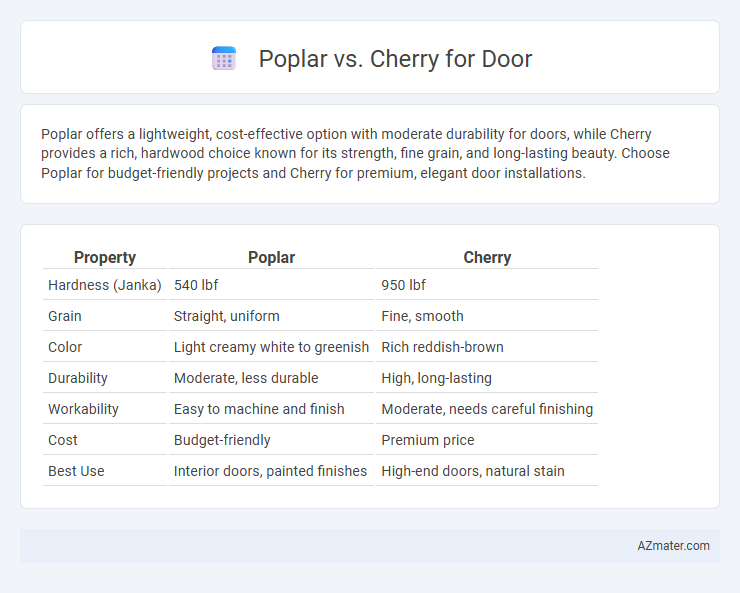Poplar offers a lightweight, cost-effective option with moderate durability for doors, while Cherry provides a rich, hardwood choice known for its strength, fine grain, and long-lasting beauty. Choose Poplar for budget-friendly projects and Cherry for premium, elegant door installations.
Table of Comparison
| Property | Poplar | Cherry |
|---|---|---|
| Hardness (Janka) | 540 lbf | 950 lbf |
| Grain | Straight, uniform | Fine, smooth |
| Color | Light creamy white to greenish | Rich reddish-brown |
| Durability | Moderate, less durable | High, long-lasting |
| Workability | Easy to machine and finish | Moderate, needs careful finishing |
| Cost | Budget-friendly | Premium price |
| Best Use | Interior doors, painted finishes | High-end doors, natural stain |
Introduction to Poplar and Cherry Wood
Poplar wood is a lightweight, soft hardwood known for its pale color and fine, straight grain, making it an economical and versatile choice for doors that can be easily painted or stained. Cherry wood, prized for its rich, reddish-brown hue and smooth texture, offers exceptional durability and a luxurious appearance that deepens with age, ideal for high-end door applications. Both woods provide unique benefits: poplar is cost-effective and workable, while cherry presents a premium finish with natural beauty and strength.
Key Differences Between Poplar and Cherry
Poplar doors are known for their affordability, lightweight nature, and smooth grain, making them easy to paint and ideal for budget-friendly projects, whereas cherry doors boast a rich, reddish-brown color, natural luster, and fine grain that deepens with age, highlighting luxury and durability. Poplar wood is softer and less dense than cherry, resulting in lower hardness and resistance to dents or scratches, but cherry offers superior strength and stability, making it suitable for high-traffic areas. The cost difference is significant, with cherry doors typically commanding a higher price due to the wood's premium quality and aesthetic appeal.
Appearance and Grain Comparison
Poplar doors exhibit a pale, creamy color with subtle green or yellow undertones, featuring a mostly straight, uniform grain that creates a smooth and consistent surface ideal for painting. Cherry doors are prized for their rich, warm reddish-brown hue that deepens with age, showcasing a fine, straight grain interspersed with occasional waves and small knots for a more textured, elegant appearance. The contrasting grain patterns and color stability of cherry offer a sophisticated and natural aesthetic, while poplar's lighter, more uniform look provides versatility and cost-effectiveness in door design.
Durability and Strength: Which is Superior?
Cherry wood outperforms poplar in both durability and strength, making it a superior choice for doors that require long-lasting sturdiness. Cherry's dense grain structure provides high resistance to dents and scratches, while poplar tends to be softer and more prone to wear over time. For doors subjected to frequent use or impact, cherry offers enhanced longevity and structural integrity compared to poplar.
Cost Analysis: Poplar vs Cherry Doors
Poplar doors are generally more cost-effective than cherry doors due to the wood's faster growth rate and greater availability, resulting in lower raw material expenses. Cherry doors, prized for their rich color and fine grain, command higher prices because of slower maturation and stronger market demand for luxury wood products. When budgeting for interior doors, choosing poplar offers significant savings without compromising durability, while cherry doors represent an investment in premium aesthetics and long-term value.
Workability and Ease of Finishing
Poplar wood offers excellent workability due to its soft texture, making it easy to saw, nail, and shape, which is ideal for intricate door designs. Cherry wood, while slightly harder, provides a smooth surface that accepts stains and finishes beautifully, enhancing the door's natural grain and color over time. Both woods allow for high-quality finishing, but poplar is more forgiving for beginners in woodworking, whereas cherry delivers a richer aesthetic appeal with expert finishing.
Popular Uses in Door Manufacturing
Poplar wood is widely favored in door manufacturing for its affordability, lightweight nature, and smooth grain that accepts paint well, making it ideal for interior doors and customizable finishes. Cherry wood, prized for its rich color, fine grain, and durability, is often chosen for high-end, solid wood doors that require a premium aesthetic and long-lasting strength. Both woods serve distinct markets, with poplar dominating budget-friendly, painted door options and cherry preferred for luxury, stained or natural-finish doors.
Maintenance Requirements and Longevity
Poplar doors require less maintenance due to their soft wood characteristics and light grain, allowing easy sanding and refinishing, but they may dent or scratch more easily. Cherry doors offer greater durability and natural resistance to wear, making them a longer-lasting option with a rich, deep color that improves over time through exposure to light. While cherry demands occasional polishing to maintain its luster, its superior longevity often offsets the slightly higher upkeep compared to poplar.
Environmental Impact and Sustainability
Poplar wood, known for its fast growth and renewable qualities, offers a lower environmental impact compared to cherry due to its shorter harvesting cycle and efficient carbon sequestration. Cherry, although prized for its durability and beauty, requires longer growth periods, contributing to higher resource consumption and reduced sustainability in door manufacturing. Choosing poplar supports sustainable forestry practices by minimizing deforestation and promoting eco-friendly material sourcing for doors.
Choosing the Right Wood for Your Door
Poplar offers a lightweight, budget-friendly option with a smooth grain that takes paint exceptionally well, making it ideal for doors requiring a painted finish. Cherry wood provides a rich, warm color and natural durability, perfect for stained or natural wood doors that need a refined, elegant appearance. Selecting between Poplar and Cherry depends on desired aesthetics, finish preferences, and budget considerations.

Infographic: Poplar vs Cherry for Door
 azmater.com
azmater.com